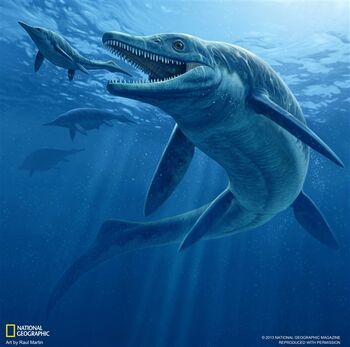| Tyrannoneustes | ||||
|---|---|---|---|---|

| ||||
| Name | Tyrannoneustes | |||
| Suborder | Thalattosuchia | |||
| Family | Geosaurinae | |||
| Name Translation | Tyrant Swimmer | |||
| Period | Mid Jurassic (165 million years ago) | |||
| Diet | Carnivore | |||
| Length | 9 meters | |||
Tyrannoneustes (tie-RAN-oh-NYOO-stuss), or "tyrant swimmer", was a large type of marine crocodile that lived during the Middle Jurassic period. It was even earlier than Metriorhynchus.
Discovery[]

Tyrannoneustes fossils
Tyrannoneustes was first discovered in the late 1800s in the Oxford Clay Formation, which is a Jurassic soil sediment found by England and originally thought to have been a close relative called Dakosaurus. It was locked away in the storage system in the Hunterian Museum in Glasgow, and remained hidden there collecting dust and untouched for over a century. It was finally taken out and re-examined in early 2013 (January) by Mark Young and some of his colleagues and found to be a whole new, largest, and oldest species of marine crocodile. The skeleton was put together, and based on its large size they dubbed it Tyrannoneustes lythrodectikos, or "Tyrant Swimmer". It has also been nicknamed as the "T. rex of the Sea" to some scientists different to Pliosaurus nickname "T. rex of the ocean". No Tyrannoneustes eggs or nests have been discovered, so little is known of the reptile's lifecycle, unlike other large marine reptiles of the Mesozoic, such as plesiosaurs or ichthyosaurs which are known to give birth to live young out at sea.
Paleobiology[]

Tyrannoneustes could easily be reffered to as being "part crocodile, part shark, and part dolphin". It had four limbs that had retained to full flippers rather than webbed-toes like modern-day crocodiles are, proving that it was equipped to a fully-aquatic life. On its tail it had a fin that closely resembled that of sharks, which helped it propell through the water much faster and easier than a normal crocodile would be able to. Also unlike modern-day crocs, Tyrannoneustes had no thick, leather-like scales for extra protection. Like modern-day crocodillians, it had very large and powerful jaws that could open quite wide, but it had serrated teeth, a feature that differs from normal crocodiles. This was likely adapted to get a hold of the slippery fish it had evolved to eat. Tyrannoneustes was likely very fast in its shallow-sea environment, which would've been a nice asset in both catching fast prey and keeping away from even larger predators, such as the giant pliosaurs like Liopleurodon. It has also been suggested that Tyrannoneustes is the first "super predator", or a predator that's capable of hunting, killing, and eating prey as big, if not bigger than itself. Although it mostly ate fish, Tyrannoneustes was also quite capable of also killing ichthyosaurs or plesiosaurs that were also in the area it was. Most scientists also believe that in the millions of years to come during the Jurassic, there were even bigger and more fierce marine crocodiles that had evolved from this tyrant swimmer.
References[]
http://news.discovery.com/animals/super-predator-130107.html
http://permalink.gmane.org/gmane.science.dinosaurs.general/56148
http://www.tandfonline.com/doi/abs/10.1080/14772019.2012.704948?journalCode=tjsp20